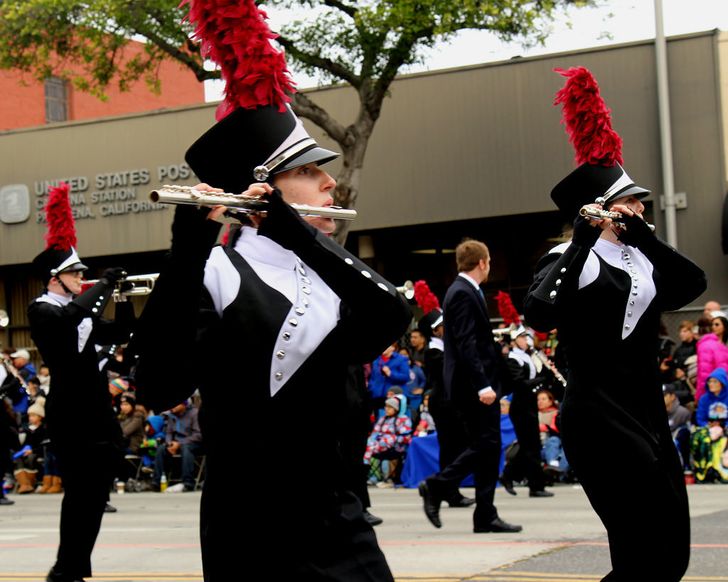Marching Band is a great time to make new friends, hang out and learn new instruments. It's definitely worth my time and I don't regret joining it. But as a flute player in Marching Band, I have a different experience than other players; some are good and some are bad. They range from individual problems to things that happen on the field and stands. By the time the season ends, I have arm muscles and bad tans just from holding the flute parallel to the ground. I love playing the flute in Marching Band, but like every good thing, there are bad things to balance it out.
1. Angles!
Most of the instruments have to be held in front of the player when playing, with the horn being around a 45-degree angle, but a flute has to be held parallel to the ground. It stretches the shoulder and other muscles that aren't used often, and it's uncomfortable because it's unnatural to hold the flute that way. When playing the flute in a band, you have to relax the shoulders so the flute will be held tilted. At first, I have had to ice or put a heat pack on my shoulders because it was painful, but over time, they didn't hurt as much. This is a very important part of playing the flute in Marching Band because it falls under visuals. When the angles aren't parallel, it will be the first thing the audience will notice. It looks good when all the flutes are parallel to the ground. I like to compare it to the statement, "Beauty is a pain."
2. Just Play Everything An octave Higher.
What's the biggest downside of playing the flute in Marching Band? You can't be heard. In an effort to be heard, we just play everything an octave higher and hope we were heard. The key word here is "try". When I get my show music, the first thing I will make sure of is if I can play everything an octave higher. I will write it down in my music. My band director is always telling us that you can only play as loud as your tone can support. The flute section exercises that rule as much as we can. I know it requires a lot of effort, but the majority of the time, we still can't be heard, yet we still try.
3. Your teeth banging into the headjoint.
Nothing hurts more than banging your teeth on the headjoint while marching or putting your instrument up to play when the teacher yells, "Band, horns up!" I would be marching backward when suddenly, my teeth bang into my mouthpiece and cause them to vibrate. It hurts a lot.
4. Icky Keys.
It's disgusting when I'm marching, and then suddenly, my keys feel slippery. I look over and see my spit coming out of my keys. As a result, my instrument becomes slippery, and it's hard to keep a grip on it while marching. I can guarantee it happens to everyone in the flute section. Then, there is the situation where the keys stick, meaning they don't open back up. When this happens, you can't play certain notes which makes us frustrated because instead of playing the note you're supposed to play, a weird sound comes out. With this, I won't be able to play half the show music, especially if the music is in the higher range - which is worse.
5. It's either the sound of angels or dying cats.
To me, the flute can be an angelic sound, or it could sound like a dying cat. There is no in between. There's more of a chance of sounding like a dying cat in Marching Band because you have to play loud and have a lot of control. It's hard to sound angelic when you're outside and have to play as loud as you can. During rehearsal, I'm expecting the dying cat sound.
6. The pain of staying in-tune.
 Giphy
GiphyTuning is a huge part of playing an instrument. It's only when staying in tune that the ensemble sounds good. It's easy to do it, but it's harder to stay in tune because It all depends on the weather. When you're not in tune, it's going to sound really bad. Since we play the flute in a higher range in Marching Band, it's easy to tell when we're not in tune, because it's going to hurt the ear. I don't tune my flute when marching outside mostly because there is no point. Since the weather is a huge factor in tuning, it's going to affect the pitch, either making it sharp or flat. I just adjust while I'm on the field.
7. The Backwards Marching Bounce.
Backward marching is not hard without holding an instrument in playing position. The flute is held across instead of vertical, meaning we use our shoulders to hold the instrument. When marching backward, you have to stay on your platforms, not let your heels touch the ground, keep your upper body still and move with your hips; otherwise, you will bounce, and when holding an instrument horizontally, it's easy to see that. This is the last thing you want because the audience will see a bouncing flute easily but won't see a bouncing clarinet. Might as well hop backward. I have been doing this for four years, and I still think it's the hardest thing to master while marching because It requires strength from your whole body.
8. Standing in front of the brass.
 Giphy
GiphyThis is more for clarinets and flutes. In my Marching Band, we form concert arcs to warm up, in which flutes and clarinets are in the first arc, and behind us are the brass instruments. It doesn't matter where the flutes are; the brass instruments are always behind us, and they are loud instruments, especially in the Marching Band. I carry a pair of earplugs with me during Marching Band season, so when I need to, I can put them in, allowing my ears some protection. The brass section, in general, is loud, but when put with the saxophones — which also stand behind the flutes and clarinets —, it's even louder. I forgot once to bring earplugs, and ever since then, I haven't forgotten again.
9. No room to march/stand.
This also pertains to the fact the flutes are held horizontally and not vertically, because of this we have to watch out and make sure we don't hit anyone and give enough room to put the flute up safely without hurting anyone. This is more of a worry during the show because if everyone is to close to each other, there's a big chance of someone getting hurt. So, along with marching and playing, flutists have to make sure they don't hit anyone during the show. For example, in this year's show, I have to pass a saxophone player in order for us to switch spots. We pass by really closely and I have eight steps to do this; along with this, I have to keep my posture and make sure I don't hit him, which makes me go around him. It's not a lot of time. I would consider this a safety issue and a priority to not hit anyone.
10. The flute sounding better outside than inside.
The flute is so destroyed by the end of the season that it ends up sounding better when you're playing outside than inside. Because of the amount of heat, cold and destruction the flute goes through, it has basically adjusted to the outside environment. I have given up on fixing it continuously, so now I don't play it inside, just outside because at that point, it does its own thing. Personally, when I play my marching flute inside a building, it sounds horrible. I have trouble getting the notes out and getting a nice tone. When I play it outside, it sounds like it is the most beautiful sound in the world. I can play all the high notes, my tone is nice and it's just easier to play. I don't really know why, but that's how it is for me.
11. Sliding.
Sliding is when you march in a different direction, but your body is facing the audience. So, when I have to walk to the right, it's easy because my shoulders and flute are already facing that direction. When I'm going to the left, I have to turn my shoulders farther and my torso farther back in order to march. It's a long and painful way to stretch and harder to play while keeping the posture. It does hurt, but it takes time to get used to and also makes the band look good while playing.
12. Lyres.
Lyres are what you put music in so you can refer to them during rehearsal. All the instruments have lyres that are attached to their instruments. For flutes, the lyre is attached to the arm. It's okay. I don't mind it that much. The downside is that I'm wearing it for two hours and by the end, I have a pattern in my skin, the area is all sweaty and there a light tan. Also, when I'm marching, the lyre tends to bounce, which makes it hard to refer to the music when I'm lost.












 Photo by
Photo by  Photo by
Photo by  Photo by
Photo by  Photo by
Photo by  Photo by
Photo by  Photo by
Photo by  Photo by
Photo by 


 File:Hampton Beach, New Hampshire - low tide - panoramio.jpg ...
File:Hampton Beach, New Hampshire - low tide - panoramio.jpg ... fire on fire pit during night time
Photo by
fire on fire pit during night time
Photo by  Free Images : american lobster, dish, new england clam bake ...
Free Images : american lobster, dish, new england clam bake ... vanilla flavor ice cream with chocolate syrup
Photo by
vanilla flavor ice cream with chocolate syrup
Photo by  File:Celebrity Silhouette (ship, 2011) 002.jpg - Wikimedia Commons
File:Celebrity Silhouette (ship, 2011) 002.jpg - Wikimedia Commons








